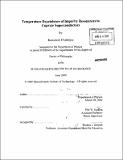Temperature dependence of impurity resonances in cuprate superconductors
Author(s)
Chatterjee, Kamalesh
DownloadFull printable version (24.57Mb)
Other Contributors
Massachusetts Institute of Technology. Dept. of Physics.
Advisor
Eric W. Hudson.
Terms of use
Metadata
Show full item recordAbstract
In conventional superconductors the superconducting gap in the electronic excitation spectrum prevents scattering of low energy electrons. In high temperature superconductors (HTS) an additional gap, the pseudogap, develops well above the superconducting transition temperature Tc. The identity of this pseudogap and its relationship to high temperature superconductivity is one of the most interesting outstanding problems in condensed matter physics today. In this thesis I present a new avenue of investigating the pseudogap state, using scanning tunneling microscopy (STM) of resonances generated by single atom scatterers. First, I report that impurity resonance peaks, near zero bias in the excitation spectrum, continue to exist above the superconducting transition temperature and prove that the impurity resonance peak is unchanged through the superconducting transition. I also show that native impurity resonances coexist spatially with the superconducting gap at low temperatures. These findings demonstrate that properties of impurity resonances in HTS are not determined by the nature of the superconducting state, as previously suggested, but instead provide new insights into the pseudogap state. I will further provide preliminary results of doping dependence as a probe to study the pseudogap. In addition to these scientific results, I will also discuss advances I have made in STM instrumentation, from a novel technology to provide the excitation for the coarse approach mechanism of the STM to current amplifier circuits for faster spectroscopy measurements.
Description
Thesis (Ph. D.)--Massachusetts Institute of Technology, Dept. of Physics, 2009. Cataloged from PDF version of thesis. Includes bibliographical references (p. 66-73).
Date issued
2009Department
Massachusetts Institute of Technology. Department of PhysicsPublisher
Massachusetts Institute of Technology
Keywords
Physics.